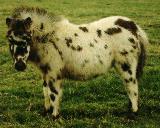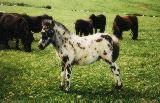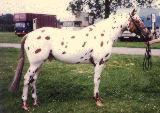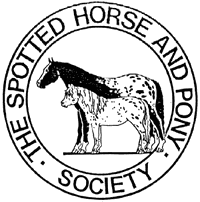| The
British Spotted Pony |
 Hermit
Renaissance owned by Mr. & Mrs. A Butterfield Hermit
Renaissance owned by Mr. & Mrs. A Butterfield |
HISTORY OF THE BRITISH SPOTTED
PONY
The spotted coat of the British spotted pony was his
natural camouflage when he roamed the heaths and forests of ancient Britain.
Stoneage man painted him on the walls of his caves, and they appear in many
illustrated manuscripts, old paintings and drawings down through the centuries.
Because of their unusual coat colouring the spotted pony was highly prized and
it is documented that they were sold for enormous sums of money and were widely
used in peace and war. In a parchment roll dated 1298 there is listed all the
horses purchased for Edward 1st campaign at Falkirk. It describes a spotted
Welsh cob from Powys purchased from Robin Fitzpayne. He is one of the most
expensive on the list. In a fifteenth century manuscript of the chronicles of
Sir John Froissart there is an illustration of a little chestnut spotted
cob.
Due to our Celtic origins, and our subsequent worship
of the horse goddess Epona we have our ancient fertility rites and dances,
which have been passed on down through time and are still enacted by our Morris
dancers and mummers in their plays throughout the country villages to this day.
one of the characters in the mummers plays is the spotted hobby horse who
represents spring growth and fertility. He would dance down the village streets
and any fair maiden he could catch and touch was supposed to become pregnant.
We know that somehow the spotted pony was linked with these ancient rites.
| The spotted pony was feral
in the British Isles, and possibly was a well known colour amongst the Welsh
hill ponies. We have many instances of spotted ponies in the old Welsh stud
books and Gwynfe Hero, a spotted Welsh cob foaled in 1916, features in some of
our oldest pedigrees. |

Hermit Renaissance
Mr. & Mrs. A Butterfield |
There have been some importation's of European blood
down through the centuries. While the Roman army brought with them their elite
officers mounts some of which were known to be spotted Spanish horses of great
elegance. Also there were many gifts of fine horses sent between the royal
families of Europe, and we snow from paintings and documents many were spotted.
There is a mid nineteenth century print of a lady believed to be Queen Victoria
driving a beautiful little Welsh-type spotted pony with a spotted Dalmatian dog
running behind. Another recorded import (again of Spanish decent) was some
Danish Knabstruppers in the early 1960's. gnome stallions were also imported by
Chipperfield's Circus for liberty work and some found their way into private
hands. Some of our modern day stallions carry this blood through Spangled
Leopard who was by Flashlight of Derriott out of a Knabstrupper mare. Sparside
Buttons is an outstanding stallion of this old line. Fairy King who was Welsh
bred was the greatest progenitor of many of our ponies and he features through
his son, Fairy Prince, in many of our oldest studs pedigrees. He strongly
influenced the Dantsley, Domino, and Ypsitty studs who have in their turn sold
stallions to many small studs throughout the UK and abroad.
 Capitall Cyrill Capitall Cyrill
owned by Mrs J Sillitoe |
After the
last war there was a great awakening of interest in the spotted pony and many
were exported to Australia, America, Canada and Holland, France and Germany.
Our studbooks relate the constant loss of some of our best mares and stallions
to the demand from abroad. During the 1960's and early 70's subsequently the
British spotted pony has become a rare breed with about 800 animals currently
registered in the society's studbooks. |
BREED CHARACTERISTICS
GENERAL:- a quality pony with adequate bone and
substance, hardy and active with real pony character of small, riding or cob
type, up to and including 14.2 hh.
All ponies MUST display some of the following:- White
sclera round the eye. Mottled skin. This part dark, part pink skin is usually
most evident around the genitals, lips, muzzle, eyes and inside the ears.
Striped hooves.
COLOUR
Leopard:- Spots of any colour on a white or light
coloured background.
Dew Spot:- Strong characteristics often
accompanied by varnish marks (groupings of dark hairs within an area, usually
nose, cheekbones, stifle, gaskin and knee).
Snowflake:- White spots on a dark base coat. This
colour can appear almost roan but must ] show strong characteristics, and often
has varnish marks which distinguish it from an ordinary roan.
Blanket:- An area of white over hips and
hindquarters with or without spots. Any base colour. The blanket can extend
over the entire back and shoulders. Piebald and Skewbald markings of any kind
are not eligible. Solid colours are eligible for a separate Register but must
be of proven spotted breeding, and preferably show some breed characteristics.
HEAD Full of quality and true pony character. Big bold
eyes set well apart. Ears should be well placed, small, neat and in proportion
to the head. Prominent, open nostrils, clean, well defined throat. A coarse
head and Roman nose are to be discouraged.
NECK Should have good length and be well carried.
Moderately lean in mares but inclined to be more cresty in stallions. Slightly
heavier neck is allowable in the cob type.
SHOULDERS Good strong, sloping and
well laid back. Withers should be well defined but not 'knifey'.
FORELEGS Should be set square and true. Not tied in at
the elbow. Long strong forearms with well developed knee. Short flat bone below
knee. Pasterns of proportionate length and slope. Well shaped tense hooves. The
cob type should have a greater abundance of bone without coarseness and a
moderate quantity of fine feather when in the rough.
BODY Muscular, strong, well coupled with plenty of heart
room. Good deep girth and well sprung ribs.
HINDQUARTERS Lengthy, strong, well muscled not ragged
or trooping, with well set on tail. Slightly finer in riding type.
HIND LEGS Well let down hocks, large flat clean bone,
prominent points. The hock not to be set behind a line from the point of
quarter to fetlock joint. No sickle or cow hocks. Pasterns to be of
proportionate length and slope. Hooves well shaped and dense.
ACTION Low, straight from the shoulder free flowing,
Hocks well flexed with straight action coming well under the body. The cob type
may show more knee action.
 |
The British
Spotted Horse and Pony Society was formed in 1947 to keep a register and
preserve them, and in 1976 the society split and the ponies under 14.2 hh were
looked after by the British spotted Pony Society. The bigger ones were entered
in the British Appaloosa Society registers. |
All the information and photos
in this section is provided courtesy of the British Spotted Horse and Pony
Society.
|

